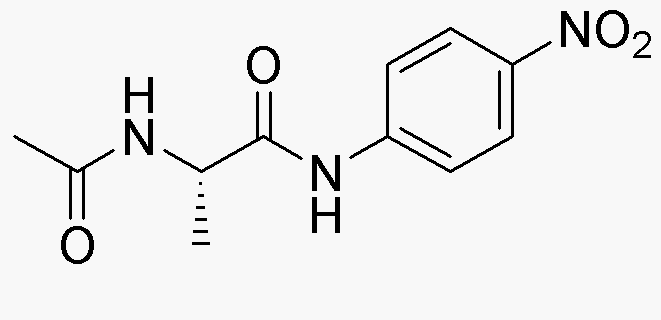Acetyl-L-alanine 4-nitroanilide is widely utilized in research focused on:
- Biochemical Assays: This compound serves as a substrate in enzyme assays, particularly for proteases, allowing researchers to measure enzyme activity effectively.
- Drug Development: Its properties make it valuable in the pharmaceutical industry for developing new drugs, especially those targeting specific enzyme pathways.
- Analytical Chemistry: It is used in chromatography and spectrophotometry for the analysis of amino acids and peptides, providing accurate quantification and characterization.
- Research on Protein Interactions: The compound aids in studying protein-ligand interactions, which is crucial for understanding biological processes and designing targeted therapies.
- Educational Purposes: It is often employed in academic laboratories for teaching students about enzyme kinetics and biochemical techniques, enhancing hands-on learning experiences.
General Information
Properties
Safety and Regulations
Applications
Acetyl-L-alanine 4-nitroanilide is widely utilized in research focused on:
- Biochemical Assays: This compound serves as a substrate in enzyme assays, particularly for proteases, allowing researchers to measure enzyme activity effectively.
- Drug Development: Its properties make it valuable in the pharmaceutical industry for developing new drugs, especially those targeting specific enzyme pathways.
- Analytical Chemistry: It is used in chromatography and spectrophotometry for the analysis of amino acids and peptides, providing accurate quantification and characterization.
- Research on Protein Interactions: The compound aids in studying protein-ligand interactions, which is crucial for understanding biological processes and designing targeted therapies.
- Educational Purposes: It is often employed in academic laboratories for teaching students about enzyme kinetics and biochemical techniques, enhancing hands-on learning experiences.
Documents
Safety Data Sheets (SDS)
The SDS provides comprehensive safety information on handling, storage, and disposal of the product.
Product Specification (PS)
The PS provides a comprehensive breakdown of the product’s properties, including chemical composition, physical state, purity, and storage requirements. It also details acceptable quality ranges and the product's intended applications.
Certificates of Analysis (COA)
Search for Certificates of Analysis (COA) by entering the products Lot Number. Lot and Batch Numbers can be found on a product’s label following the words ‘Lot’ or ‘Batch’.
*Catalog Number
*Lot Number
Certificates Of Origin (COO)
This COO confirms the country where the product was manufactured, and also details the materials and components used in it and whether it is derived from natural, synthetic, or other specific sources. This certificate may be required for customs, trade, and regulatory compliance.
*Catalog Number
*Lot Number
Safety Data Sheets (SDS)
The SDS provides comprehensive safety information on handling, storage, and disposal of the product.
DownloadProduct Specification (PS)
The PS provides a comprehensive breakdown of the product’s properties, including chemical composition, physical state, purity, and storage requirements. It also details acceptable quality ranges and the product's intended applications.
DownloadCertificates of Analysis (COA)
Search for Certificates of Analysis (COA) by entering the products Lot Number. Lot and Batch Numbers can be found on a product’s label following the words ‘Lot’ or ‘Batch’.
*Catalog Number
*Lot Number
Certificates Of Origin (COO)
This COO confirms the country where the product was manufactured, and also details the materials and components used in it and whether it is derived from natural, synthetic, or other specific sources. This certificate may be required for customs, trade, and regulatory compliance.


